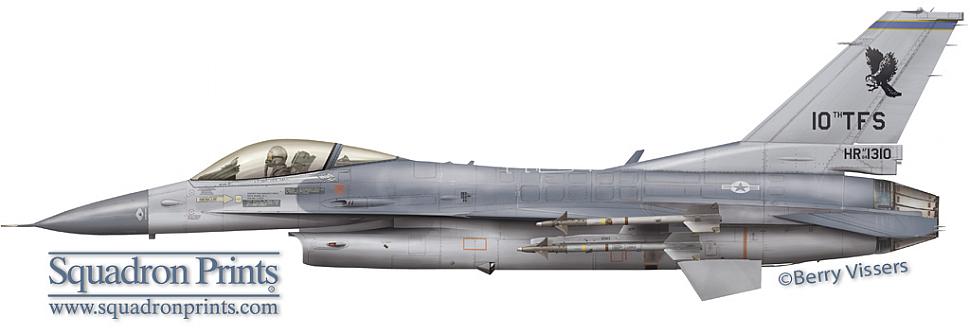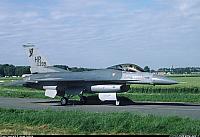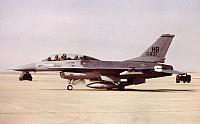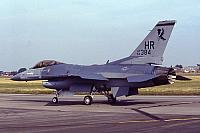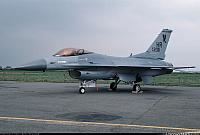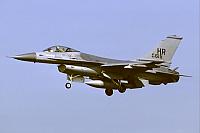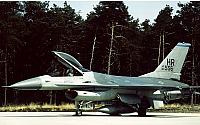 |
10th Tactical Fighter Squadron ( USAFE)" Fighting Tenth" |
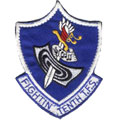 |
10 TFS " Fighting Tenth" ( USAFE) | |||
| Status: |
Disbanded
|
|||
| Version: | F-16C/D block 25 | |||
| Role: | Air Defence, Attack, Strike | |||
| Tailband: | Blue | |||
| Motto: | N/A | |||
| Badge: | N/A | |||
|
Disbanded on September 30th, 1991.
|
||||
F-16 History
The second squadron of the 50th TFW to receive the brand-new F-16 fighters was the 10th TFS. Since its sister squadron – the 313th TFS - was already flying the type, ground crew could get familiarized with the airframe and the technical procedures over there. Hahn was selected to receive these new jets as it was a frontline base in the center of Germany. Since the wing had a distinct air-to-ground task, it was decided to wait until the block 15 version became available, because that was optimised for this role.
The first jets started to arrive in the summer of 1982 – after the 313th TFS received its full lot. The entire package was delivered in mid 1983. The squadron became fully operational in October of 1983. Since the weather at Hahn isn’t always perfect - certainly not in the winter months - the squadron deployed to Zaragoza in Spain to train on the Bardenas-Reales range. This range provides vast opportunities for live weapons releases and air maneuvering to be trained.
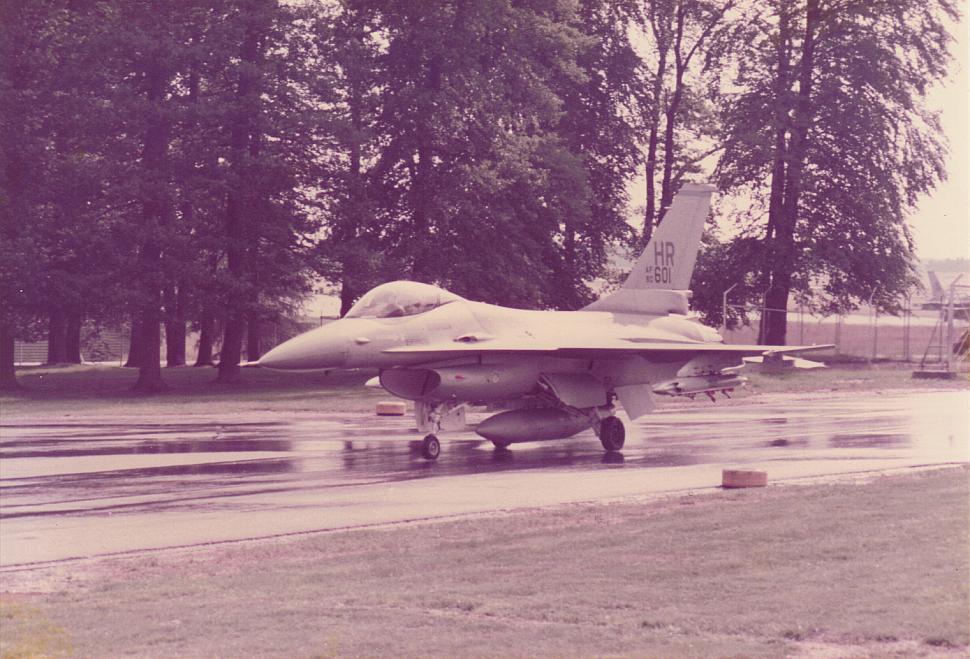
The squadron’s role was a primary air defence role in the hart of the US corridor within West-Germany. Since the squadron was part of a Tactical Fighter Wing an advanced air-to-ground role was also part of the package. Last but not least, the squadron also had a strike role to perform. Hahn AFB housed a number of B-43 or B-61 nuclear devices and the F-16s were tasked to perform this tactical nuclear role as well. Therefore the squadron had to wait until the block 15 arrived, since the nuclear capability of the F-16 was incorporated in this airframe type and operationally released.
The USAF always provided the latest blocks to the most important operational units. After only having flown a mere 4 years on the block 15 version, the squadron already received the more capable F-16C and D models with the acceptance of block 25 airframes in 1986. The squadron was operational on the type by December 31st, 1986. The role of the squadron remained the same.
After the end of the Cold War the USAF had a major overcapacity of fighter units in Europe. In 1990 the decision came to disband the entire 50th TFW and its subordinate squadrons and to close down Hahn AFB all together. Despite this news, the squadron was tasked in late 1990 to get prepared for an overseas deployment. The 10th TFS was sent to Al Dhafra AFB in the United Arab Emirates. They became operational on December 28th, 1990 in the desert and stayed there until May 10th, 1991. A total of 1,300 mission were flown in Operation Desert Storm during the 43 day conflict. When they returned there wasn’t very much time left and the squadron was disbanded on September 30th, 1991 and so ended 38 years of European operations.
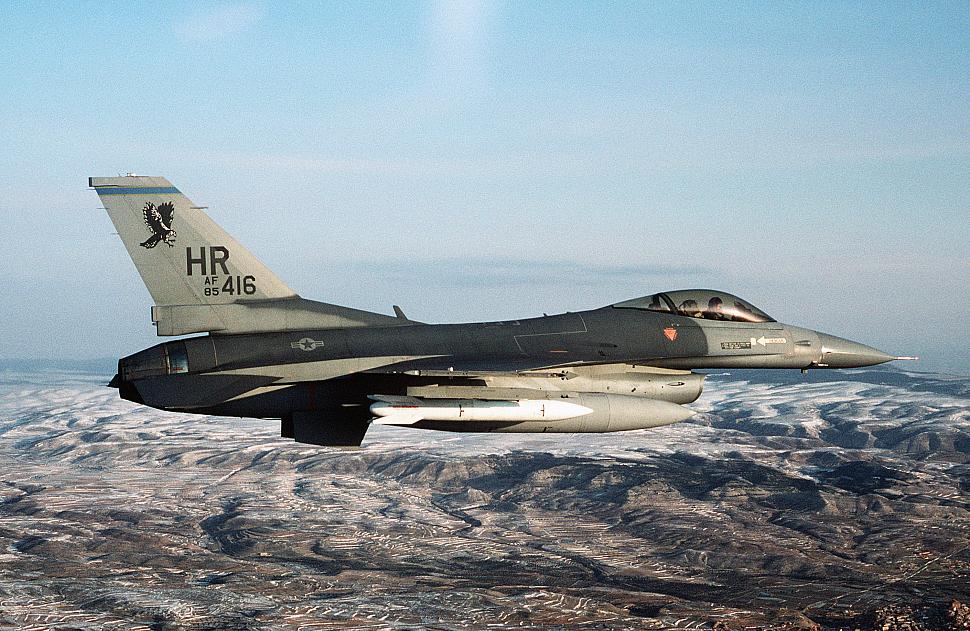
Aircraft Markings History
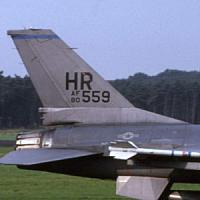
On top of the tail was a blue tailband. In the center the tailcode 'HR' (referring to Hunsrück - Dogs back - reflecting the landscape around Hahn AFB) with the serial underneath.
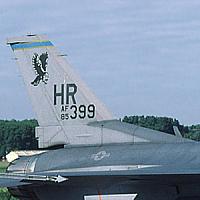
The general lay-out remained the same, but a falcon was added above the tailcode with the introduction of the C/D models.
Unit History
- 1940: Activation of the squadron in Selfridge, Michigan
- 1940: BT-13 'Valiant' (part of 50 PG)
- 1941: BT-13 'Valiant' (Key Field, Mississippi)
- 1941: P-35
- 1942: P-40 'Warhawk' (Orlando AFB, Florida)
- 1943: P-51 'Mustang' (Zephyrhills AP, Florida)
- 1944: P-47 'Thunderbolt II' (Orlando AFB, Florida)
- 1944: P-47 'Thunderbolt II' (Lymington [Eng.])
- 1944: P-47 'Thunderbolt II' (Carentan [Fr.])
- 1944: P-47 'Thunderbolt II' (Meautis [Fr.])
- 1944: P-47 'Thunderbolt II' (Orly [Fr.])
- 1944: P-47 'Thunderbolt II' (Laon [Fr.])
- 1944: P-47 'Thunderbolt II' (Lyon [Fr.])
- 1944: P-47 'Thunderbolt II' (Toul [Fr.])
- 1945: P-47 'Thunderbolt II' (Giebelstadt [Germ.])
- 1945: P-47 'Thunderbolt II' (Mannheim [Germ.])
- 1945: P-47 'Thunderbolt II' (La Junta Field, Colorado)
- 1945: Disbanded
- 1949: Activation of the squadron in Langley, Virginia
- 1949: No aircraft assigned
- 1951: Disbanded
- 1953: Activation of the squadron in Clover, New Mexico
- 1953: F-51 'Mustang' (part of 50 FBG)
- 1953: F-86 'Sabre' (Hahn AFB [Germ.])
- 1956: F-86 'Sabre' (Toul/Rosières AFB [Fr.])
- 1958: F-100 'Super Sabre'
- 1959: F-100 'Super Sabre' (Hahn AFB [Germ.])
- 1966: F-4D 'Phantom II'
- 1977: F-4E 'Phantom II'
- 1982: F-16A/B 'Fighting Falcon'
- 1986: F-16C/D 'Fighting Falcon'
- 1991: Disbanded
Deployments
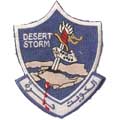 |
' Desert Storm' |
| Al Dhafra AB, UAE (December 28th, 1990 to May 10th, 1991) | |
| Deployed for Operation Desert Shield which became Desert Storm. The entire squadron was deployed with the assistance of the other two Hahn based squadrons. Air strikes began on the morning of January 17, 1991. A total of 1,300 missions were flown. |
F-16 Airframe Inventory
- All 10 TFS F-16s in our F-16 Aircraft Database (past and current aircraft)
- Current 10 TFS F-16s in our F-16 Aircraft Database
Photos
Special Thanks
Michael & Deborah Taschner
Please use this form to add any list any error or omissions you find in the above text.
Note: your comments will be displayed immediately on this page. If you wish to send a private comment to the webmasters, please use the Contact Us link.

